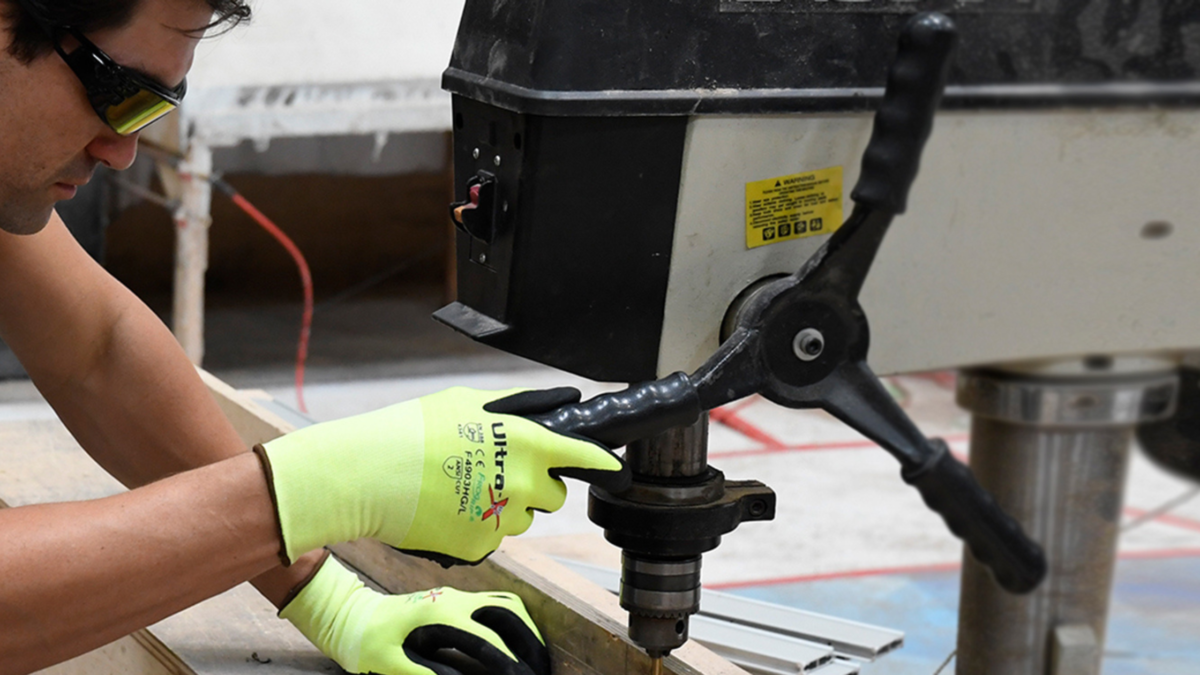Cuts and lacerations are common workplace injuries. According to data from the Ohio Bureau of Workers’ Compensation, approximately 30% of all workplace injuries fall under this category, with a staggering 70% of these incidents affecting the hands or fingers. One crucial step in addressing these hazards is selecting gloves that meet or exceed the appropriate cut level for a specific work task. Read on to learn more about cut-resistant work gloves and ensure the safety of your workforce on the job.
What Are Cut-Resistant Gloves?
Cut-resistant gloves play a crucial role as Personal Protective Equipment (PPE) for workers across diverse industries such as manufacturing, automotive, construction, or other environments where cut protection is paramount. These gloves are designed to protect workers from common workplace hazards including cuts, lacerations, abrasions, and other injuries that can hinder job performance.
Cut-resistant gloves are textile products specially engineered to protect against direct contact with sharp surfaces. Manufacturers design them with the capacity to withstand cutting and slashing, minimizing the wearer’s risk of accidents and severe injury.
The Significance of Cut-Resistant Gloves
Beyond the immediate physical protection they offer, cut-resistant gloves play a vital role in maintaining the overall health of your workforce. Cuts pose a significant risk of exposing the injured employee to blood-borne pathogens, infections, or diseases. Apart from the initial laceration and potential exposure to further issues, the injured employee may endure ongoing health complications, resulting in costly consequences.
According to the National Safety Council, a hand injury can cost anywhere from $540 to $26,000 and injuries to the hand are the second most common type of workplace injury. This makes a big impact on workers’ compensation claims, emphasizing the importance cut-resistant gloves have on mitigating long-term health and financial risks.
Exploring the Different Cut-Resistant Glove Materials
Not all cut-resistant gloves are created equal. These gloves can come in various materials depending on your specific needs. Here are some of these materials along with their respective benefits and disadvantages.
- Aramid or DuPontTM Kevlar®
Kevlar® is the trademarked brand name for the aramid fiber made by DuPontTM, its name is synonymous with the term aramid. Kevlar is one of the strongest man-made fibers available with excellent cut protection and heat insulation. It is designed to protect hands from the sharp edges of metals, ceramics, glass, and other materials. Pound for pound it is five times stronger than stainless steel.
- High Performance Polyethylene (HPPE)
HPPE fibers are specially designed to protect against cuts and abrasions when handling sharp and abrasive objects. These fibers can be engineered in a variety of composite-knit yarns, some featuring high-strength composite fiber blends for higher cut resistance and dexterity.
- All-Metal Chainmail
While less common, metal can be used as the sole material in manufacturing cut-resistant gloves. Referred to as chainmail gloves, these gloves are made of metal rings linked together in a pattern to form a mesh. These gloves provide a high level of cut resistance, but significantly limit the user’s range of motion.
- Basalt
Basalt fiber, extracted from crushed basalt rock, offers fine continuous filaments with superior strength characteristics. It is naturally fire-resistant and provides high cut resistance, tensile strength, and good abrasion resistance.
- Glass Fiber
Glass fiber is a well-known yarn for cut-resistant gloves, offering a smooth and silky surface for enhanced comfort. It can be used as the sole component for cut resistance or to reinforce other fibers, providing high tensile strength, cut resistance, fire resistance, water resistance, and non-conductivity.
Understanding Cut Levels
Cut-resistant gloves vary in their resistance and strength. The higher the cut level, the more heavy-duty and cut-resistant the glove is. The ANSI/ISEA 105-2016 standard, established by the American National Standard Institute, utilizes a nine-level scale, which provides a quick guide for identifying the appropriate cut-resistant gloves required for the specific hazard faced.
This standard assesses cut resistance on a scale from 0 to 6,000 grams, based on tests by a Tomodynamometer (TDM Method), which moves a blade across the material being tested. The weight required to cut the material determines the level of cut resistance. A higher rating on the scale translates to better protection and cut performance.
The chart below illustrates all nine cut levels, ranging from A2 to A9.
Choosing the Right Cut-Resistant Glove
When determining the right cut-resistant glove for you, it’s essential to consider the task at hand and the potential hazards that the task presents. The chart above serves as a general guide to help you in making this determination. For personalized guidance and support, reach out to a Liberty Safety representative to get connected to one of our product experts.
January Product Promo
Start the New Year with savings! Explore our January Product Promo, featuring highlighted items from our cut-resistant gloves line. Dive into the unique features that set these gloves apart.
➡️ Request A Personalized Quote
Your safety is our priority. It’s all part of our Freedom in Full Gear promise!

